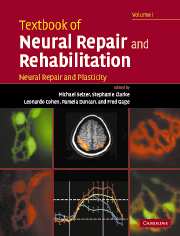Book contents
- Frontmatter
- Contents
- Contents (contents of Volume II)
- Preface
- Contributors (contributors of Volume I)
- Contributors (contributors of Volume II)
- Neural repair and rehabilitation: an introduction
- Section A Neural plasticity
- Section A1 Cellular and molecular mechanisms of neural plasticity
- 1 Anatomical and biochemical plasticity of neurons: regenerative growth of axons, sprouting, pruning, and denervation supersensitivity
- 2 Learning and memory: basic principles and model systems
- 3 Short-term plasticity: facilitation and post-tetanic potentiation
- 4 Long-term potentiation and long-term depression
- 5 Cellular and molecular mechanisms of associative and nonassociative learning
- Section A2 Functional plasticity in CNS system
- Section A3 Plasticity after injury to the CNS
- Section B1 Neural repair
- Section B2 Determinants of regeneration in the injured nervous system
- Section B3 Promotion of regeneration in the injured nervous system
- Section B4 Translational research: application to human neural injury
- Index
4 - Long-term potentiation and long-term depression
from Section A1 - Cellular and molecular mechanisms of neural plasticity
Published online by Cambridge University Press: 05 March 2012
- Frontmatter
- Contents
- Contents (contents of Volume II)
- Preface
- Contributors (contributors of Volume I)
- Contributors (contributors of Volume II)
- Neural repair and rehabilitation: an introduction
- Section A Neural plasticity
- Section A1 Cellular and molecular mechanisms of neural plasticity
- 1 Anatomical and biochemical plasticity of neurons: regenerative growth of axons, sprouting, pruning, and denervation supersensitivity
- 2 Learning and memory: basic principles and model systems
- 3 Short-term plasticity: facilitation and post-tetanic potentiation
- 4 Long-term potentiation and long-term depression
- 5 Cellular and molecular mechanisms of associative and nonassociative learning
- Section A2 Functional plasticity in CNS system
- Section A3 Plasticity after injury to the CNS
- Section B1 Neural repair
- Section B2 Determinants of regeneration in the injured nervous system
- Section B3 Promotion of regeneration in the injured nervous system
- Section B4 Translational research: application to human neural injury
- Index
Summary
Keywords
- Type
- Chapter
- Information
- Textbook of Neural Repair and Rehabilitation , pp. 60 - 78Publisher: Cambridge University PressPrint publication year: 2006
- 1
- Cited by



